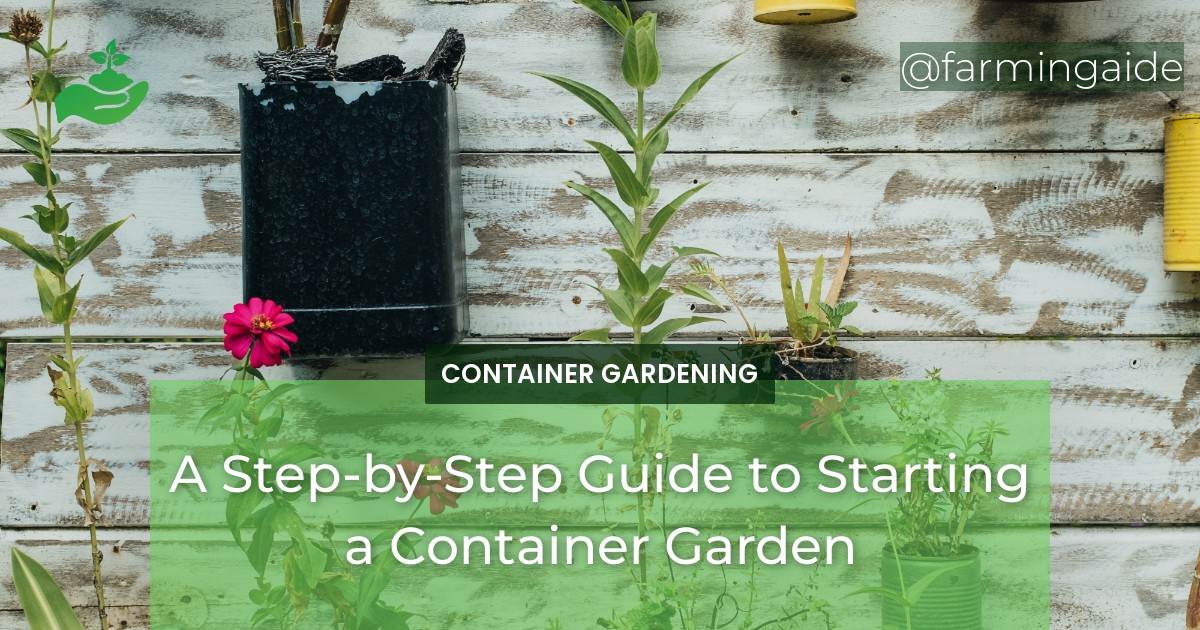Container gardening is a wonderful way to enjoy fresh produce and beautiful flowers without needing a large garden space. With the right containers, soil, and plants, anyone can start a thriving container garden.
This guide will take you through everything you need to know with starting a container gardening.
Table of Contents
Choosing Containers and Soil
Selecting the Right Type of Container
When choosing containers for your container garden, you want to consider both form and function. Choose containers that are the right size for the plants you want to grow, and that have adequate drainage. Some common container materials include:
- Terra cotta
- Plastic
- Ceramic
- Wood
When selecting containers, make sure they are sturdy enough to support the weight of the mature plants and soil. You can also repurpose items like old buckets, tires, or even a wheelbarrow as long as they have proper drainage holes.
Choosing the Right Soil for Container Gardening
The soil you use for container gardening is just as important as the container itself. You want to use a lightweight, nutrient-rich soil that drains well. Look for a potting mix that is specifically formulated for container gardening, as these will usually contain peat moss, vermiculite, and perlite.
- Do not use soil from your garden as it is too heavy for container gardening and may contain pests or diseases.
- Consider adding a slow-release fertilizer to your soil mix before planting, as container plants often have less access to nutrients than those in the ground.
Choosing Plants for Container Gardening
Determining Which Plants are Suitable for Container Gardening
Almost any plant can be grown in a container, but some are better suited for it than others. Some popular container plants include:
- Tomatoes
- Peppers
- Lettuce
- Herbs
- Flowers
When choosing plants, consider the container size, the amount of sunlight the plants will receive, and the climate in your area. Some plants, like tomatoes, require a lot of space, while others, like herbs, can be grown in smaller containers. If you have limited sunlight, consider plants like lettuce or herbs that do well in partially shaded areas.
Factors to Consider When Choosing Plants for Container Gardening
- Choose plants that have similar sunlight and water needs if planting in the same container.
- Consider the mature size of the plant when choosing the container size.
- Some plants may need support structures like stakes or trellises as they grow.
- Be sure to choose disease-resistant varieties to prevent problems later in the season.
ALSO READ
Preparing the Containers for Planting
Preparing the Containers for Planting
Before you plant your container garden, you need to prepare the containers. Clean the containers with soapy water and rinse thoroughly. If using a used container, sterilize it with a solution of one part bleach to nine parts water. Rinse well with water and let dry completely.
Adding Fertilizer to the Soil
Before planting, add a slow-release fertilizer to the soil. This will provide your plants with nutrients throughout the growing season. You can also add compost or other organic matter to the soil for additional nutrients.
Planting Your Container Garden
Planting Your Container Garden
When planting your container garden, fill the container with soil up to a few inches below the rim. Dig a hole in the soil slightly larger than the root ball of your plant. Carefully remove the plant from its container and loosen the roots. Place the plant in the hole and fill in around it with soil. Water thoroughly.
Watering Your Container Garden
One of the most important aspects of container gardening is proper watering. Container plants can dry out quickly, especially during hot weather. Water your plants when the top inch of soil is dry. Water until excess water drains out of the holes in the bottom of the container.
ALSO READ
Maintaining Your Container Garden
Regular Maintenance for Container Gardening
Container gardens require regular maintenance to stay healthy and productive. Here are some tasks to keep in mind:
- Remove any dead or diseased leaves and flowers.
- Pinch back herbs to encourage bushier growth.
- Stake or support any plants that need it.
- Monitor plants for pests or disease and treat as needed.
Pest Control and Disease Prevention
One of the biggest challenges of container gardening is pest and disease control. To prevent problems, keep your containers clean and free of debris. Monitor your plants for signs of pests or disease, and treat as soon as possible. Organic solutions include spraying with insecticidal soap or neem oil. It is also important to rotate crops and not plant the same type of plant in the same container year after year.
Harvesting Your Container Garden
When and How to Harvest Your Container Garden
The joy of container gardening is harvesting fresh produce and beautiful flowers. Harvesting times vary depending on the plant. Some plants, like lettuces and herbs, can be harvested as soon as they are large enough to use. Others, like tomatoes and peppers, will need to ripen on the vine before harvesting.
Tips for Maximizing Your Yield
- Harvest regularly to encourage more growth.
- Pinch back herbs to keep them bushy and productive.
- Use a trellis or stake for plants like tomatoes or cucumbers to maximize space and yield.
How Can I Apply the Steps for Starting a Container Garden to Growing Strawberries in Containers?
If you’re new to growing strawberries in containers, the “complete guide to growing strawberries” is a great resource to help you get started. Applying the steps for starting a container garden to growing strawberries will ensure that you have a successful harvest of delicious, juicy berries right on your patio or balcony.
Conclusion
Starting a container garden may seem overwhelming, but with the right containers, soil, and plants, anyone can do it. By following these steps, you can enjoy fresh produce and beautiful flowers all season long. Happy gardening!
RELATED ARTICLES:


